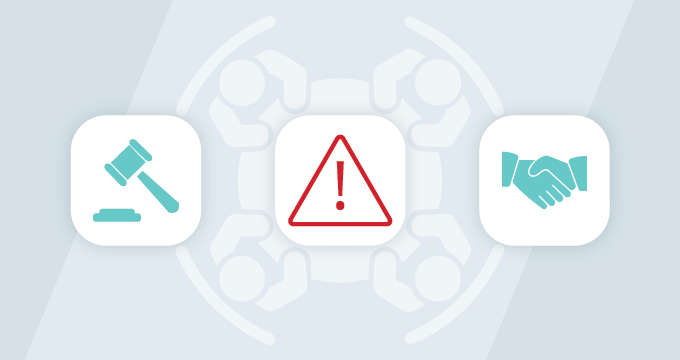Records management policy is the backbone of organizational efficiency. It ensures that important records are systematically managed from creation to disposal.
This policy helps maintain the integrity and accessibility of vital information and is essential for complying with legal and regulatory standards.
In this article, we’ll cover:
- Four reasons why you need a records management policy
- Five steps for creating one (with a template)
- The main challenges in records management and how you can solve them
Why You Need a Records Management Policy
A records management policy is a set of guidelines and practices that dictate how an organization manages its records. This encompasses the entire records lifecycle, including their creation, use, storage, and eventual disposal.
The primary purpose of this policy is to:
- Ensure organizational efficiency — A clear policy can help organize records, making them easier to locate and use.
- Help with legal and regulatory compliance — Different industries are subject to various legal and regulatory requirements concerning record-keeping.
- Ensure data protection and privacy — With increasing concerns over data security and privacy, a records management policy safeguards sensitive information.
- Improve business continuity and disaster recovery — In case of unforeseen events, a robust records management system ensures that critical information is preserved and can be recovered to maintain business operations.
The connection with document management policy
Here’s how these two policies intersect and support each other:
Complementary functions
While records management focuses on the life cycle of records necessary for compliance and historical purposes, document management encompasses a broader range of documents, including those in active use for daily operations. Together, they ensure efficient management of all organizational documents, whether they are records or not.
Unified management system
Integrating records management policies within the broader document management system helps create a unified platform for managing all types of documents. This integration promotes consistency, reduces redundancy, and enhances accessibility.
Enhanced compliance and security
The overlap between records and document management in terms of compliance and security protocols ensures a comprehensive cover. Adhering to policies in both areas will strengthen your organization’s legal compliance and data protection status.
Streamlining processes
A cohesive approach, where document management policies account for records management principles, can streamline processes like retrieval, archiving, and disposal. This not only saves time but also reduces the risk of errors.
Technological integration
Leveraging technology platforms that cater to records and document management needs, such as archiving software, can provide seamless, efficient, and more secure information management.
Steps for Creating a Records Management Policy
To develop a comprehensive records management policy, you need several critical components that ensure its effectiveness in managing your records efficiently and legally.
Scope and applicability
- Define the boundaries — Clearly outline the types of records covered under the policy, including digital and physical formats. This should encompass emails, official documents, employee records, and financial records.
- Apply across departments — The policy should apply universally to ensure consistency in records management throughout the organization.
Responsibility and accountability
- Assign roles — Designate specific roles and responsibilities for managing records, such as Records Manager, Information Officer, or Departmental Record Coordinator.
- Organize proper training — Arrange regular training and awareness programs to educate staff on their roles and the importance of adherence to the policy.
Records classification and retention
- Create a classification system — Establish a classification system for records based on their nature, purpose, and confidentiality level, ensuring efficient retrieval and management.
- Set a retention schedule — Define clear retention periods for different categories of records, based on legal requirements and organizational needs, specifying how long each type of record should be kept.
Records access and security
- Access control — Outline rules for who can access what records, incorporating necessary restrictions to protect sensitive information.
- Set security protocols — Implement security measures to protect records from unauthorized access, alteration, loss, or destruction.
Compliance and legal requirements
- Review regulatory policies — Ensure that the policy is in compliance with relevant laws, regulations, and industry standards of records management.
- Schedule audits and reviews — Include provisions for regular audits to verify compliance and identify areas for improvement.
Based on the components we just described, here’s a template you can use for creating your records management policy:
| Steps for Implementing a Records Management Policy | Actionable Items |
| 1. Policy Development |
|
| 2. Approval and Ratification |
|
| 3. Staff Training and Awareness |
|
| 4. Assigning Roles and Responsibilities |
|
| 5. Implementation of Classification System |
|
| 6. Establishing a Retention Schedule |
|
| 7. Ensuring Access Control and Security |
|
| 8. Compliance and Regular Audits |
|
| 9. Review and Continuous Improvement |
|
Challenges and Solutions in Records Management
Implementing and maintaining a records management policy is challenging. Organizations must navigate various obstacles, from technological changes to compliance issues.
Here’s how to address some of these common challenges:
Dealing with digital transformation
Challenge: Rapid technological advancements mean records are increasingly digital, requiring new management approaches.
Solution: Update the records management policy regularly to include guidelines for digital records. Invest in digital tools and training to manage electronic records effectively.
Balancing accessibility and security
Challenge: Ensuring records are easily accessible while maintaining high-security standards can be difficult.
Solution: Implement role-based access controls and encryption for sensitive records. Regularly review and update security protocols.
Adapting to regulatory changes
Challenge: Keeping up with changes in laws and regulations that affect record-keeping can be challenging.
Solution: Establish a process for reviewing legal changes regularly and engage with legal experts to ensure the policy remains compliant.
Addressing these challenges head-on with thoughtful strategies and proactive measures is key to maintaining an effective records management system.
Importance of Data Archiving Software
Data archiving software is crucial in a comprehensive records management strategy. It offers several key benefits:
- Long-term preservation — Data archiving software ensures the long-term preservation of important records, safeguarding them from technological obsolescence or data degradation.
- Regulatory compliance — Many archiving solutions are designed to meet specific industry regulations, helping organizations comply with legal requirements for data retention and protection.
- Efficient data retrieval — Archiving solutions provide efficient retrieval mechanisms, making it easier to access historical data when needed, which is especially important for audits or legal inquiries.
- Reduced storage costs — Archiving infrequently accessed data can optimize your organizations’ storage infrastructure, potentially leading to significant cost savings.
Summary of the Main Points
Here’s a quick recap:
- A records management policy is a set of guidelines and practices that dictate how an organization manages its records.
- Having it will ensure operational efficiency and compliance with legal and regulatory standards.
- To create an effective records management policy, you need to define its scope and make sure it applies universally to all departments, create a classification system to separate different types of records, define retention schedules for each class, establish access controls and security protocols, assign roles to users to control access, train the staff regularly, and establish regular audits.
- Integrating technology, especially data archiving software and document management systems, will considerably improve these processes.
- A good records management policy is a living document that evolves with the organization’s needs and external regulatory changes. Staying vigilant and adaptable is key to maintaining an effective records management strategy.
Jatheon’s cloud email archiving solution can help you capture data automatically, find important information, and manage your data with ease.
FAQ
What is the difference between records management and document management?
Records management focuses on the records lifecycle required for legal, historical, or compliance reasons, while document management is a broader term that encompasses the management of all documents within an organization, including those in active use.
How often should a records management policy be reviewed and updated?
It’s recommended that the records management policy be reviewed and potentially updated annually or more frequently if there are significant changes in technology, business practices, or legal regulations.
What are the key legal considerations in records management?
Key legal considerations include compliance with data protection laws, adhering to industry-specific regulations, ensuring appropriate data retention periods, and maintaining adequate security measures to protect sensitive information.
Read Next:Document Retention Policy and Requests for Production |







